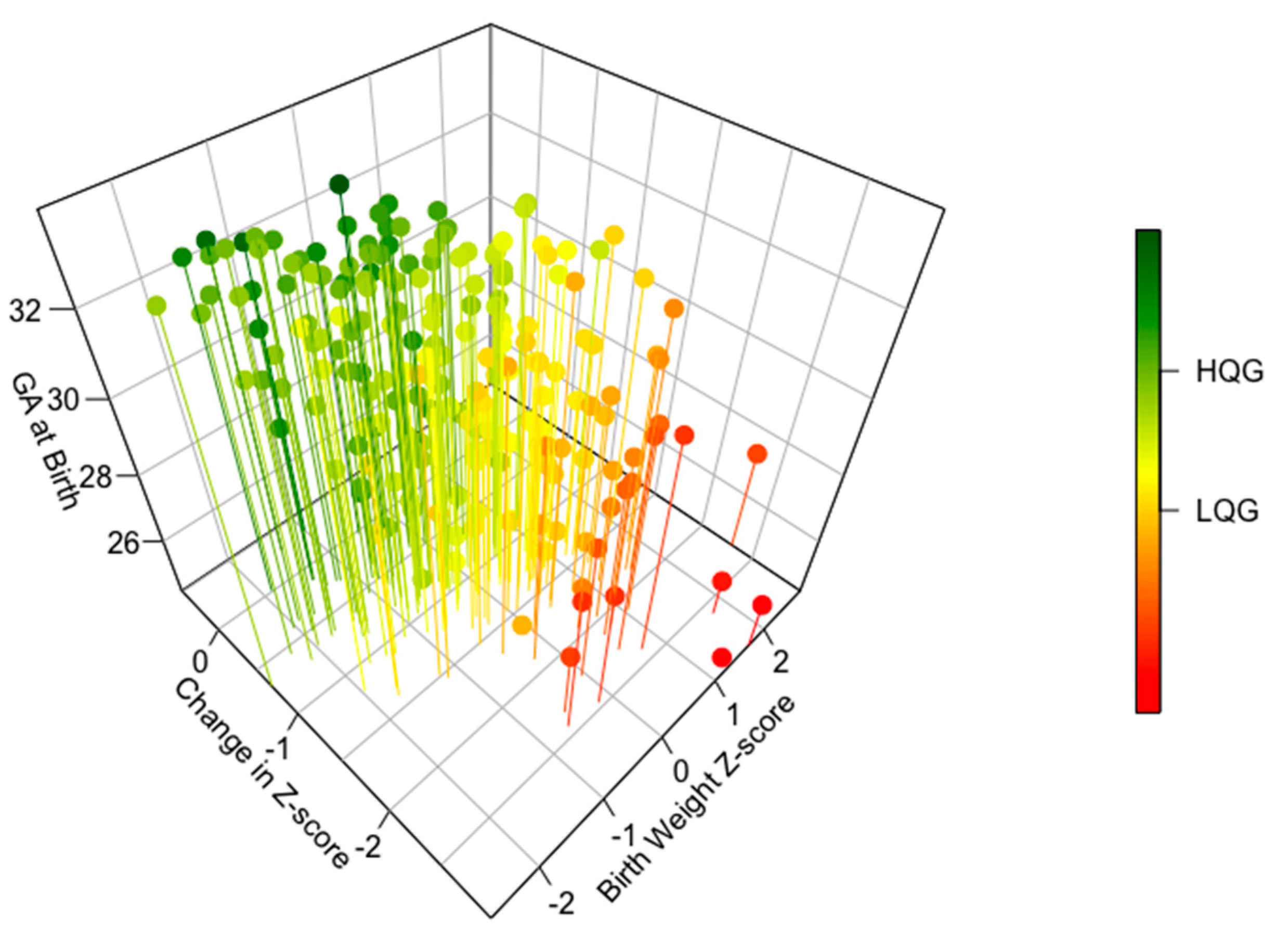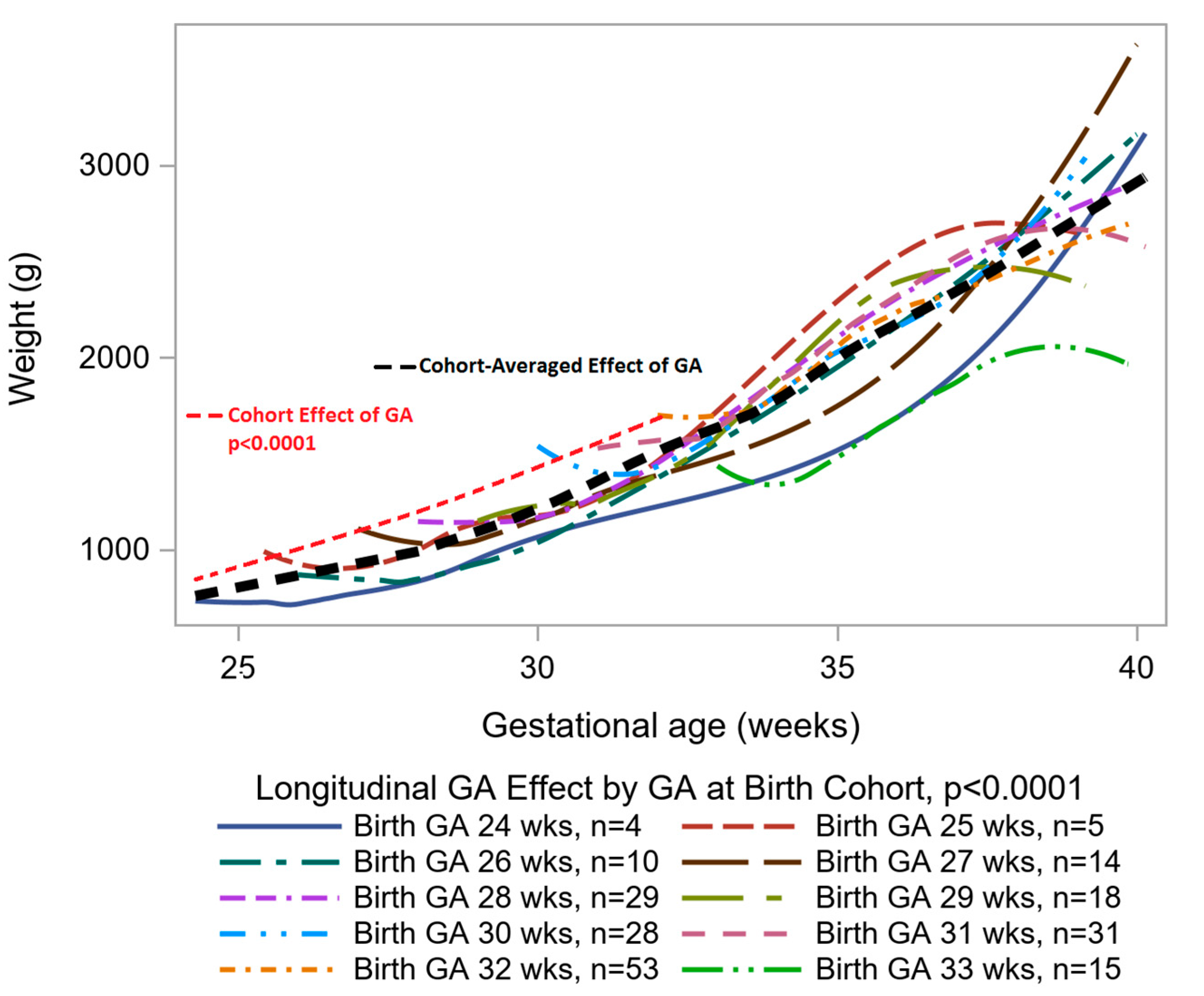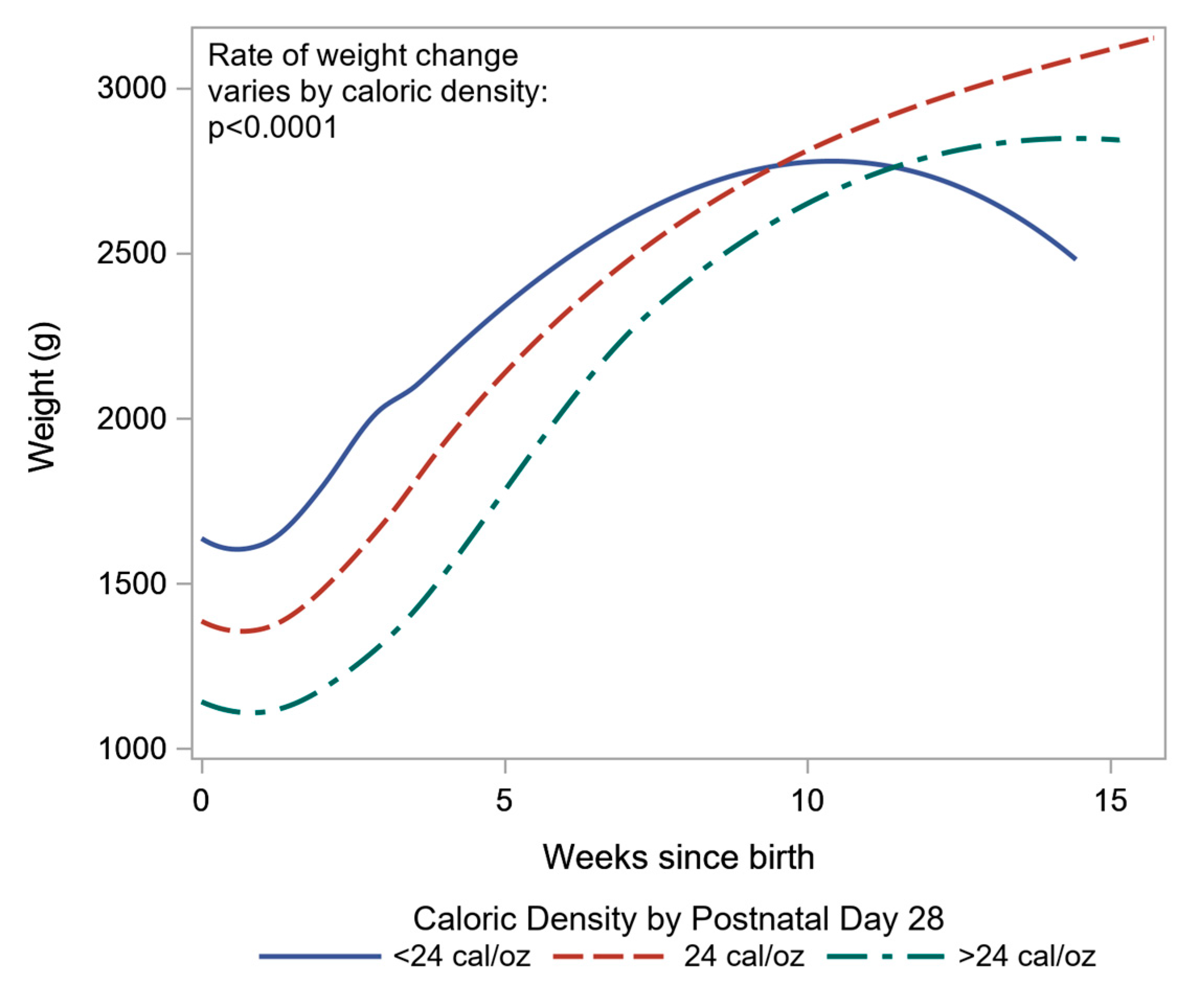Factors in Early Feeding Practices That May Influence Growth and the Challenges That Arise in Growth Outcomes Research
Abstract
1. Introduction
2. Materials and Methods
2.1. Study Population
2.2. Outcome and Predictors of Interest
2.3. Statistical Analysis
3. Results
4. Discussion
5. Conclusions
Author Contributions
Funding
Acknowledgments
Conflicts of Interest
Appendix A
| Characteristic | Zdiff ≤ −1.34 1 (Number = 51) | −1.34 < Zdiff ≤ −0.93 1 (Number = 51) | −0.93 < Zdiff ≤ −0.57 1 (Number = 51) | Zdiff > −0.57 1 (Number = 51) | Total (Number = 204) | p-Value 6 |
|---|---|---|---|---|---|---|
| Sex (female/male) | 25/26 | 22/29 | 28/23 | 21/30 | 96/108 | 0.5 |
| Race (number) | 0.53 | |||||
| Black or African American | 10 | 12 | 16 | 12 | 50 | |
| White or Caucasian | 24 | 25 | 27 | 24 | 100 | |
| Other | 17 | 14 | 8 | 15 | 54 | |
| Comorbidities (yes/no) | ||||||
| Grade III IVH 2 | 1/50 | 1/50 | 0/51 | 0/51 | 2/202 | 1.00 |
| Grade IV IVH | 1/50 | 0/51 | 0/51 | 1/50 | 2/202 | 1.00 |
| NEC 3 | 0/51 | 1/50 | 0/51 | 0/51 | 1/203 | 1.00 |
| PDA 4 | 5/46 | 4/47 | 6/45 | 3/48 | 18/186 | 0.84 |
| SGA 5 | 1/50 | 2/49 | 6/45 | 3/48 | 12/192 | 0.24 |
| Zdiff ≤ −1.34 1 (Number = 51) | −1.34 < Zdiff ≤ −0.93 1 (Number = 51) | −0.93 < Zdiff ≤ −0.57 1 (Number = 51) | Zdiff > −0.57 1 (Number = 51) | Total (Number = 204) | p-Value 2 | |
|---|---|---|---|---|---|---|
| Gestational Age at Birth (weeks) | ||||||
| Median (Range) | 29.4 (24.3–32.9) | 30.1 (24.9–33.6) | 31.4 (24.4–33.9) | 32.1 (26.0–33.9) | 30.9 (24.3–33.9) | <0.001 |
| Gestational Age at Discharge (weeks) | ||||||
| Median (Range) | 37.6 (35.0–39.3) | 36.9 (35.0–39.9) | 36.4 (35.0–40.0) | 36.6 (35.4–40.0) | 36.7 (35.0–40.0) | 0.11 |
| Length of Stay (days) | ||||||
| Median (Range) | 59.0 (15.0–100.0) | 46.0 (17.0–105.0) | 39.0 (16.0–109.0) | 32.0 (18.0–93.0) | 44.0 (15.0–109.0) | <0.001 |
| Growth Parameter | Zdiff ≤ −1.34 1 (Number = 51) | −1.34 < Zdiff ≤ −0.93 1 (Number = 51) | −0.93 < Zdiff ≤ −0.57 1 (Number = 51) | Zdiff > −0.57 1 (Number = 51) | Total (Number = 204) | p-Value 2 |
|---|---|---|---|---|---|---|
| Birth Weight (g) | ||||||
| Mean (SD) 3 | 1371.86 (389.62) | 1350.90 (345.53) | 1424.94 (425.38) | 1428.04 (357.61) | 1393.94 (379.46) | 0.67 |
| Birth Weight z-score | ||||||
| Mean (SD) | 0.53 (0.89) | −0.08 (0.77) | −0.28 (1.02) | −0.67 (0.80) | −0.12 (0.97) | <0.001 |
| Birth Length (cm) | ||||||
| Mean (SD) | 38.76 (3.79) | 38.59 (3.62) | 39.45 (4.09) | 39.98 (3.38) | 39.20 (3.75) | 0.21 |
| Birth Length z-score | ||||||
| Mean (SD) | 0.46 (1.01) | −0.11 (1.03) | −0.18 (1.29) | −0.39 (0.88) | −0.06 (1.10) | <0.001 |
| Birth Head Circumference (cm) | ||||||
| Mean (SD) | 26.91 (2.23) | 27.11 (2.09) | 27.75 (2.53) | 27.88 (2.18) | 27.41 (2.28) | 0.08 |
| Birth Head Circumference z-score | ||||||
| Mean (SD) | 0.35 (0.87) | −0.09 (0.97) | −0.14 (1.19) | −0.52 (1.06) | −0.10 (1.07) | <0.001 |
| Discharge Weight (g) | ||||||
| Mean (SD) | 2451.12 (372.19) | 2397.10 (376.48) | 2410.67 (458.92) | 2431.57 (444.86) | 2422.61 (412.40) | 0.92 |
| Discharge Weight z-score | ||||||
| Mean (SD) | −1.26 (0.88) | −1.22 (0.75) | −1.06 (0.98) | −0.96 (0.87) | −1.13 (0.88) | 0.28 |
| Discharge Length (cm) | ||||||
| Mean (SD) | 46.25 (2.55) | 45.50 (2.45) | 45.50 (2.75) | 45.30 (2.37) | 45.64 (2.54) | 0.25 |
| Discharge Length z-score | ||||||
| Mean (SD) | −0.90 (1.13) | −1.05 (0.96) | −0.92 (1.11) | −0.98 (0.94) | −0.96 (1.03) | 0.88 |
| Discharge Head Circumference (cm) | ||||||
| Mean (SD) | 31.98 (1.74) | 31.92 (1.44) | 31.98 (1.77) | 32.00 (1.49) | 31.97 (1.60) | 0.99 |
| Discharge Head Circumference z-score | ||||||
| Mean (SD) | −0.99 (0.97) | −0.88 (0.81) | −0.71 (1.03) | −0.66 (0.82) | −0.81 (0.92) | 0.25 |
| Growth Velocity (gm/kg/day) | ||||||
| Median (Range) | 10.7 (0.9–13.2) | 11.7 (4.2–16.6) | 12.7 (7.5–16.7) | 14.2 (10.2−20.8) | 12.1 (0.9 – 20.8) | <0.001 |
| Change in Length z-score | ||||||
| Mean (SD) | −1.36 (0.94) | −0.94 (0.85) | −0.74 (0.76) | −0.59 (0.65) | −0.91 (0.85) | <0.001 |
| Change in Weight z-score | ||||||
| Mean (SD) | −1.79 (0.41) | −1.14 (0.11) | −0.79 (0.10) | −0.29 (0.24) | −1.0 (0.60) | <0.001 |
| Change in Head Circumference z-score | ||||||
| Mean (SD) | −1.35 (0.85) | −0.78 (0.73) | −0.57 (0.77) | −0.14 (0.70) | −0.71 (0.87) | <0.001 |
References
- Ehrenkranz, R.A.; Dusick, A.M.; Vohr, B.R.; Wright, L.L.; Wrage, L.A.; Poole, W.K. Growth in the neonatal intensive care unit influences neurodevelopmental and growth outcomes of extremely low birth weight infants. Pediatrics 2006, 117, 1253–1261. [Google Scholar] [CrossRef] [PubMed]
- Shah, P.S.; Wong, K.Y.; Merko, S.; Bishara, R.; Dunn, M.; Asztalos, E.; Darling, P.B. Postnatal growth failure in preterm infants: Ascertainment and relation to long-term outcome. J. Perinat. Med. 2006, 34, 484–489. [Google Scholar] [CrossRef] [PubMed]
- Franz, A.R.; Pohlandt, F.; Bode, H.; Mihatsch, W.A.; Sander, S.; Kron, M.; Steinmacher, J. Intrauterine, early neonatal, and postdischarge growth and neurodevelopmental outcome at 5.4 years in extremely preterm infants after intensive neonatal nutritional support. Pediatrics 2009, 123, e101–e109. [Google Scholar] [CrossRef] [PubMed]
- Belfort, M.B.; Rifas-Shiman, S.L.; Sullivan, T.; Collins, C.T.; McPhee, A.J.; Ryan, P.; Kleinman, K.P.; Gillman, M.W.; Gibson, R.A.; Makrides, M. Infant growth before and after term: Effects on neurodevelopment in preterm infants. Pediatrics 2011, 128, e899–e906. [Google Scholar] [CrossRef]
- Zozaya, C.; Díaz, C.; Saenz de Pipaón, M. How should we define postnatal growth restriction in preterm infants? Neonatology 2018, 114, 177–180. [Google Scholar] [CrossRef]
- Hay, W.W.; Lucas, A.; Heird, W.C.; Ziegler, E.; Levin, E.; Grave, G.D.; Catz, C.S.; Yaffe, S.J. Workshop summary: Nutrition of the extremely low birth weight infant. Pediatrics 1999, 104, 1360–1368. [Google Scholar] [CrossRef]
- Su, B.H. Optimizing nutrition in preterm infants. Pediatr. Neonatol. 2014, 55, 5–13. [Google Scholar] [CrossRef]
- Fenton, T.R.; Kim, J.H. A systematic review and meta-analysis to revise the Fenton growth chart for preterm infants. BMC Pediatr. 2013, 13, 59. [Google Scholar] [CrossRef]
- Patel, A.L.; Engstrom, J.L.; Meier, P.P.; Kimura, R.E. Accuracy of methods for calculating postnatal growth velocity for extremely low birth weight infants. Pediatrics 2005, 116, 1466–1473. [Google Scholar] [CrossRef]
- Lunceford, J.K.; Davidian, M. Stratification and weighting via the propensity score in estimation of causal treatment effects: A comparative study. Stat. Med. 2004, 23, 2937–2960. [Google Scholar] [CrossRef]
- Imbens, G.W.; Rubin, D.B. Causal Inference for Statistics, Social, and Biomedical Sciences: An Introduction; Cambridge University Press: New York, NY, USA, 2015. [Google Scholar]
- Morgan, S.L.; Winship, C. Counterfactuals and Causal Inference: Methods and Principles for Social Research, 2nd ed.; Cambridge University Press: New York, NY, USA, 2015. [Google Scholar]
- Berzuini, C.; Dawid, P.; Bernardinelli, L. (Eds.) Causality: Statistical Perspectives and Applications; John Wiley & Sons: Chichester, UK, 2012. [Google Scholar]
- Auctin, P.C. Balance diagnostics for comparing the distribution of baseline covariates between treatment groups in propensity-score matched samples. Stat. Med. 2009, 28, 3083–3107. [Google Scholar]
- Culpepper, C.; Hendrickson, K.; Marshall, S.; Benes, J.; Grover, T.R. Implementation of feeding guidelines hastens the time to initiation of enteral feeds and improves growth velocity in very low birth-weight infants. Adv. Neonatal. Care 2017, 17, 139–145. [Google Scholar] [CrossRef] [PubMed]
- Quigley, M.; Embleton, N.D.; McGuire, W. Formula versus donor breast milk for feeding preterm or low birth weight infants. Cochrane Database Syst. Rev. 2019, 7, CD002971. [Google Scholar] [CrossRef] [PubMed]
- O’Connor, D.L.; Jacobs, J.; Hall, R.; Adamkin, D.; Auestad, N.; Castillo, M.; Connor, W.E.; Connor, S.L.; Fitzgerald, K.; Groh-Wargo, S.; et al. Growth and development of premature infants fed predominantly human milk, predominantly premature infant formula, or a combination of human milk and premature formula. J. Pediatr. Gastroenterol. Nutr. 2003, 37, 437–446. [Google Scholar] [CrossRef]
- Olsen, I.E.; Groveman, S.A.; Lawson, M.L.; Clark, R.H.; Zemel, B.S. New intrauterine growth curves based on United States data. Pediatrics 2010, 125, e214–e224. [Google Scholar] [CrossRef]
- Villar, J.; Giuliani, F.; Fenton, T.R.; Ohuma, E.O.; Ismail, L.C.; Kennedy, S.H. INTERGROWTH-21st very preterm size at birth reference charts. Lancet 2016, 387, 844–845. [Google Scholar] [CrossRef]
- Fenton, T.R.; Anderson, D.; Groh-Wargo, S.; Hoyos, A.; Ehrenkranz, R.A.; Senterre, T. An attempt to standardize the calculation of growth velocity of preterm infants-evaluation of practical bedside methods. J. Pediatr. 2018, 196, 77–83. [Google Scholar] [CrossRef]
- Peila, C.; Spada, E.; Giuliani, F.; Maiocco, G.; Raia, M.; Cresi, F.; Bertino, E.; Coscia, A. Extrauterine growth restriction: Definitions and predictability of outcomes in a cohort of very low birth weight infants or preterm neonates. Nutrients 2020, 12, 1224. [Google Scholar] [CrossRef]
- Rochow, N.; Raja, P.; Liu, K.; Fenton, T.; Landau-Crangle, E.; Göttler, S.; Jahn, A.; Lee, S.; Seigel, S.; Campbell, D.; et al. Physiological adjustment to postnatal growth trajectories in healthy preterm infants. Pediatr. Res. 2016, 79, 870–879. [Google Scholar] [CrossRef] [PubMed]
- Rochow, N.; Landau-Crangle, E.; So, H.Y.; Pelc, A.; Fusch, G.; Däbritz, J.; Göpel, W.; Fusch, C. Z-score differences based on cross-sectional growth charts do not reflect the growth rate of very low birth weight infants. PLoS ONE 2019, 14, e0216048. [Google Scholar] [CrossRef]
- Goldberg, D.L.; Becker, P.J.; Brigham, K.; Carlson, S.; Fleck, L.; Gollins, L.; Sandrock, M.; Fullmer, M.; Van Poots, H.A. Identifying malnutrition in preterm and neonatal populations: Recommended indicators. J. Acad. Nutr. Diet 2018, 118, 1571–1582. [Google Scholar] [CrossRef] [PubMed]
- Andrews, E.T.; Ashton, J.J.; Pearson, F.; Beattie, R.M.; Johnson, M.J. Early postnatal growth failure in preterm infants is not inevitable. Arch. Dis. Child. Fetal Neonatal Ed. 2019, 104, F235–F241. [Google Scholar] [CrossRef] [PubMed]
- Landau-Crangle, E.; Rochow, N.; Fenton, T.R.; Liu, K.; Ali, A.; So, H.Y.; Fusch, G.; Marrin, M.L.; Fusch, C. Individualized postnatal growth trajectories for preterm infants. J. Parenter. Enteral Nutr. 2018, 42, 1084–1092. [Google Scholar] [CrossRef] [PubMed]



| Characteristic | LGQ (Number = 51) | HGQ (Number = 51) | p-Value 5 |
|---|---|---|---|
| Sex (female/male) | 25/26 | 21/30 | 0.43 |
| Race (number) | 0.86 | ||
| Black or African American | 10 | 12 | |
| White or Caucasian | 24 | 24 | |
| Other | 17 | 15 | |
| Comorbidities (yes/no) | |||
| Grade III IVH 1 | 1/50 | 0/51 | 1.00 |
| Grade IV IVH | 1/50 | 1/50 | 1.00 |
| NEC 2 | 0/51 | 0/51 | 1.00 |
| PDA 3 | 5/46 | 3/48 | 0.72 |
| SGA 4 | 1/50 | 3/48 | 0.62 |
| LGQ (Number = 51) | HGQ (Number = 51) | p-Value 1 | |
|---|---|---|---|
| Gestational Age at Birth (weeks) | |||
| Median (Range) | 29.4 (24.3–32.9) | 32.1 (26.0–33.9) | <0.001 |
| Gestational Age at Discharge (weeks) | |||
| Median (Range) | 37.6 (35.0–39.3) | 36.6 (35.4–40.0) | 0.021 |
| Length of Stay (days) | |||
| Median (Range) | 59.0 (15.0–100.0) | 32.0 (18.0–93.0) | <0.001 |
| Growth Parameter | LGQ (Number = 51) | HGQ (Number = 51) | p-Value 1 |
|---|---|---|---|
| Birth Weight (g) | |||
| Mean (SD) 2 | 1371.86 (389.62) | 1428.04 (357.61) | 0.45 |
| Birth Weight z-score | |||
| Mean (SD) | 0.53 (0.89) | −0.67 (0.80) | <0.001 |
| Birth Length (cm) | |||
| Mean (SD) | 38.76 (3.79) | 39.98 (3.38) | 0.09 |
| Birth Length z-score | |||
| Mean (SD) | 0.46 (1.01) | −0.39 (0.88) | <0.001 |
| Birth Head Circumference (cm) | |||
| Mean (SD) | 26.91 (2.23) | 27.88 (2.18) | 0.028 |
| Birth Head Circumference z-score | |||
| Mean (SD) | 0.35 (0.87) | −0.52 (1.06) | <0.001 |
| Discharge Weight (g) | |||
| Mean (SD) | 2451.12 (372.19) | 2431.57 (444.86) | 0.81 |
| Discharge Weight z-score | |||
| Mean (SD) | −1.26 (0.88) | −0.96 (0.87) | 0.09 |
| Discharge Length (cm) | |||
| Mean (SD) | 46.25 (2.55) | 45.30 (2.37) | 0.06 |
| Discharge Length z-score | |||
| Mean (SD) | −0.90 (1.13) | −0.98 (0.94) | 0.70 |
| Discharge Head Circumference (cm) | |||
| Mean (SD) | 31.98 (1.74) | 32.00 (1.49) | 0.94 |
| Discharge Head Circumference z-score | |||
| Mean (SD) | −0.99 (0.97) | −0.66 (0.82) | 0.07 |
| Growth Velocity (gm/kg/day) | |||
| Median (Range) | 10.7 (0.9–13.2) | 14.2 (10.2–20.8) | <0.001 |
| Change in Weight z-score | |||
| Mean (SD) | −1.79 (0.41) | −0.29 (0.24) | <0.001 |
| Change in Length z-score | |||
| Mean (SD) | −1.36 (0.94) | −0.59 (0.65) | <0.001 |
| Change in Head Circumference z-score | |||
| Mean (SD) | −1.35 (0.85) | −0.14 (0.70) | <0.001 |
© 2020 by the authors. Licensee MDPI, Basel, Switzerland. This article is an open access article distributed under the terms and conditions of the Creative Commons Attribution (CC BY) license (http://creativecommons.org/licenses/by/4.0/).
Share and Cite
Fabrizio, V.; Shabanova, V.; Taylor, S.N. Factors in Early Feeding Practices That May Influence Growth and the Challenges That Arise in Growth Outcomes Research. Nutrients 2020, 12, 1939. https://doi.org/10.3390/nu12071939
Fabrizio V, Shabanova V, Taylor SN. Factors in Early Feeding Practices That May Influence Growth and the Challenges That Arise in Growth Outcomes Research. Nutrients. 2020; 12(7):1939. https://doi.org/10.3390/nu12071939
Chicago/Turabian StyleFabrizio, Veronica, Veronika Shabanova, and Sarah N. Taylor. 2020. "Factors in Early Feeding Practices That May Influence Growth and the Challenges That Arise in Growth Outcomes Research" Nutrients 12, no. 7: 1939. https://doi.org/10.3390/nu12071939
APA StyleFabrizio, V., Shabanova, V., & Taylor, S. N. (2020). Factors in Early Feeding Practices That May Influence Growth and the Challenges That Arise in Growth Outcomes Research. Nutrients, 12(7), 1939. https://doi.org/10.3390/nu12071939






